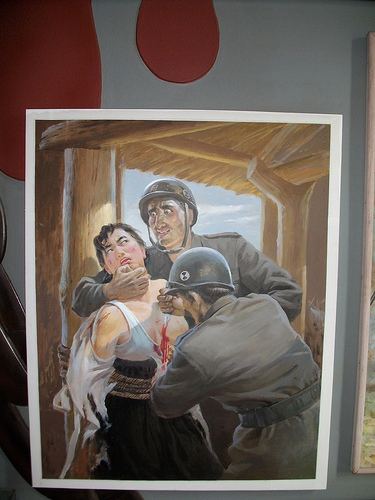 | ||
Date 17 October – 7 December 1950 Location Sinchon County, South Hwanghae Province, North Korea | ||
Sinchon massacre
The Sinchon Massacre (Korean: 신천 양민학살 사건, Hanja: 信川良民虐殺事件, Sinchon Civilian Massacre) was an alleged mass murder of civilians claimed by North Korean sources to have been committed primarily by South Korean military forces under allowance from the U.S. military between 17 October and 7 December 1950, in or near the town of Sinchon (currently part of South Hwanghae Province, North Korea). The event place during the second phase of the Korean War and the retreat of the DPRK government from Hwanghae Province.
Contents

North Korean claim

North Korean sources claim that approximately 35,000 people were killed by American military forces and other supporters during the course of 52 days, which would have been about a quarter of the population of Sinchon. The Sinchon Museum of American War Atrocities was established in 1958 and displays remains and belongings of those who are claimed to have been killed in the incident. Kim Jong-il visited the museum in 1998, and Kim Jong-un visited in November 2014 to "strengthen the anti-U.S. lessons for our military and people... and to powerfully unite the 10 million soldiers and people in the battle against the United States". In July 2015, Kim Jong-un visited again with senior military official Hwang Pyong-so, revealing a major expansion of the Sinchon Massacre museum.
NGO claims

In a report prepared in Pyongyang, the non-governmental but allegedly Communist-affiliated International Association of Democratic Lawyers lists several alleged incidents of mass murder by U.S. soldiers in Sinchon, alongside claims that the American troops had beheaded up to 300 North Koreans using Japanese samurai swords and that the US Air Force was using bacteriological warfare in Korea. Relying on oral testimony from North Koreans, the International Association of Democratic Lawyers report claims that the Sinchon massacre was overseen by a General Harrison or Halison, an apparent reference to William Kelly Harrison, who they allege personally conducted many atrocities. Their report claims that Harrison took photos of the massacre. There is no evidence to confirm their testimony, and Harrison was reportedly shocked by the claim. Other reports also concluded there was no Harrison in the area at the time, and that it was either a pseudonym or a false claim.

According to Dong-Choon Kim, a former Commissioner of the Truth and Reconciliation Commission, the Sinchon massacre was carried out by "right-wing security police and a youth group." Sunghoon Han also states that "right-wing security units" were responsible for the killings. South Korean novelist Hwang Sok-yong's "The Guest," based on interviews with a Korean Christian pastor, also addresses the Sinchon massacre.

In 1989, noted Chicago Tribune journalist Uli Schmitzer summarized "If any truth about massacres in Chichon (Sinchon) ever existed, the evidence has long ago been obscured. The town, 70 miles south of the North Korean capital, Pyongyang, has been turned into a national shrine by a ruthless propaganda machine that has fueled anti-American passions for 36 years in support of an institutionalized, regimented communist regime."

Author Bruce Cumings, in his book "War and Television" stated "the major part of the Sinch’on massacres were carried out by Korean Christians who had fled the Sinch’on area for the South. In my opinion, If any Americans were present they were probably KMAG (Korean Military Advisory Group) personnel, who witnessed many South Korean atrocities against civilians; the Koreans I spoke with were adamant that Americans had carried out the massacres, but it is also true that Koreans do not like to admit that Koreans could do such things, unless they are following American or (in the colonial period) Japanese orders."

